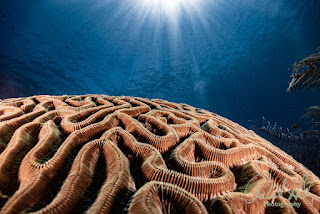AI-Powered Color Recovery for Underwater Photos: Bringing Back True Tones
This blog updates a previously written blog (Nov 6, 2024—How to Recover Lost Colors in Underwater Photos Using Lightroom). Adobe is constantly updating its tools and capabilities. These new AI tools require me to take a fresh approach to color correction for underwater photos. I hope this update helps you in your editing.
Underwater photography poses unique challenges, with color loss being one of the most significant obstacles. The deeper you dive, the more reds, oranges, and yellows fade away, leaving your images dominated by blues and greens. Fortunately, Adobe Lightroom's AI-driven tools are transforming underwater photo editing, making it easier than ever to restore true-to-life colors.
This comprehensive guide explores the science of
underwater color loss, the latest AI-powered tools in Lightroom, and
step-by-step workflows for precise color restoration. By the end, you'll
have five powerful techniques to transform dull,
colorless images into vibrant, high-impact underwater shots.
Understanding the Science of Color Loss Underwater
Water absorbs different wavelengths of light at varying
rates, leading to progressive color loss as depth increases:
- Red
disappears first (~10-15 feet deep).
- Orange
fades next (~20-25 feet deep).
- Yellow
weakens significantly (~35 feet deep).
- Green
lasts longer but is absorbed beyond 50-60 feet.
- Blue
penetrates deepest, dominating the color palette below 60 feet.
Without artificial lighting like strobes, your photos will
have a blue-green cast, low contrast, and lack the warm tones our eyes
expect. Lightroom's AI-powered color recovery tools intelligently
counteract these effects, restoring natural colors and vibrancy.
AI-Powered Tools in Lightroom for Underwater Color
Recovery
With Lightroom's latest AI-powered tools, you can make precise, automated corrections that previously required manual
adjustments. Here are the top AI-driven features that will help restore lost
underwater colors:
- AI
White Balance Correction: Automatically corrects color casts for a
more natural look.
- AI-Powered
Masking: Intelligent selection of subjects, backgrounds, or water
conditions.
- Adaptive
Presets: Smart presets dynamically adjust based on your photo's
unique characteristics.
- AI-Powered
Dehaze and Clarity Enhancements: Reduces haze and enhances mid-tones
for crisp details.
- Neural
Filters in Photoshop: Uses deep-learning technology to intelligently
recolor underwater scenes.
Each tool plays a crucial role in recovering
lost colors and enhancing contrast, and we'll walk through their practical
applications below.
Example 1: AI-Powered White Balance Correction
Why It's Important: White balance correction is the
foundation of color recovery. AI-enhanced auto white balance provides a more innovative way to counteract blue-green color casts.
Steps:
- Open
your underwater image in the Develop Module (D).
- Navigate
to the White Balance (WB) Selector in the Basic panel.
- Click
on the Eyedropper Tool (W) and select a neutral gray or white area
in your image (e.g., sand, a neutral rock).
- If
needed, fine-tune the Temp slider (move right to warm up the image)
and Tint slider (move right to reduce green tones).
- Use
the Auto setting for AI-powered white balance correction, which
analyzes the image and applies intelligent adjustments.
Pro Tip: If your image still has excessive blue
tones, use the AI Adaptive Preset for Warm Tones to refine the
correction further.
Example 2: AI-Driven Masking for Selective Color
Correction
Why It's Important: AI-powered masking allows precise
color adjustments on specific elements like coral, fish, or divers without
affecting the entire image.
Steps:
- Click
on the Masking tool (Shift + W).
- Choose
Select Subject or Select Background (AI will detect and mask
the subject or background automatically).
- Apply
a custom White Balance adjustment to the selected area.
- Use
the Color Mixer (HSL Panel) to enhance specific colors. Increase Reds,
Oranges, and Yellows to bring back warmth.
- If
needed, apply Color Grading to highlights, midtones, and shadows to
further refine tones.
Pro Tip: Use AI Select Background to decrease
the blues and greens in the water while keeping the subject's colors vibrant.
Example 3: AI-Adaptive Presets for Instant Color
Enhancement
Why It's Important: AI-adaptive presets analyze each
image and apply dynamic corrections based on exposure, contrast, and color
balance.
Steps:
- Navigate
to the Presets Panel (Shift + P).
- Scroll
to Adaptive Presets > Color and apply presets like "Underwater
Vibrancy" or "Warm Tones Boost."
- Fine-tune
the Vibrance (Ctrl + Shift + V) and Saturation (Ctrl + Shift + U)
sliders to match the desired effect.
- If
additional refinement is needed, use the HSL Panel to adjust
individual color tones.
Pro Tip: Adaptive Presets work best as a starting
point—adjust sliders manually for personalized results.
Example 4: AI-Powered Dehaze and Clarity Adjustments for
Murky Water
Why It's Important: AI-powered Dehaze and Clarity
tools help cut through the haze caused by light scattering in water, restoring
contrast and depth.
Steps:
- Open
the Effects Panel (Ctrl + 7).
- Increase
Dehaze (Shift + Ctrl + D) to reduce underwater murkiness.
- Adjust
Clarity (Ctrl + Shift + C) to enhance mid-tone contrast, making the
image sharper.
- Use AI
Masking > Select Background to reduce Dehaze in the background
while keeping the foreground natural.
- Apply Radial
Filters (Shift + M) around your subject to further balance clarity and
contrast.
Pro Tip: Lower the Luminance of Blues in the HSL
panel to create a deeper, richer water background.
Example 5: AI Neural Filters for Advanced Color
Restoration
Why It's Important: The latest AI-powered Neural
Filters (available through Lightroom and Photoshop) can intelligently
restore lost colors by analyzing the image's content.
Steps:
- In
Lightroom, right-click the image and choose Edit in Photoshop (Ctrl
+ E).
- In
Photoshop, navigate to Filter > Neural Filters > Colorize
(Adobe's AI will analyze and restore natural colors).
- Adjust
the Color Balance sliders to fine-tune the effect.
- Save
and return to Lightroom (Ctrl + S) to apply additional
refinements.
Pro Tip: Colorize AI in Photoshop for extreme, in-depth images where traditional methods fail.
Final Thoughts: Bringing the Ocean's True Colors Back to
Life
AI-powered tools in Lightroom make underwater color recovery
faster, smarter, and more precise than ever. Whether using AI
masking, adaptive presets, or Neural Filters, these techniques allow you to
restore the brilliance of marine life with minimal effort.
Incorporating these five AI-driven techniques can enhance your underwater images with professional-grade precision. Explore Lightroom's AI capabilities and transform your underwater photography
with true-to-life colors!
Join My Online Training Program
Interested in learning how to edit underwater photos like
a pro? My online training program teaches Lightroom techniques to
take your underwater photography to the next level. Contact me at bob@robertherb.com to learn more!
Happy editing, and may your photos capture the ocean's magic exactly as you saw it!
- 💡 Read more Lightroom tips at RobertHerb.blogspot.com.
- 💡 Join my upcoming online training program – Learn to enhance your underwater shots with Adobe Lightroom! Send me an email so I can add you to my list.
- 💡 Share your processed photos on social media using #RobertHerbPhotography.
- 💡 Have questions? Email me at bob@robertherb.com.
Written by Robert Herb – Empowering underwater photographers to capture and enhance the beauty of our oceans.
Stay tuned for more in-depth insights into underwater photography. Let’s dive deeper into the art and craft of capturing the marine world! If you have any comments or suggestions, I’d love to hear them.
Get ready for an exciting underwater photography adventure! For more details on my upcoming online training course, check out my "Training" page at RobertHerb.com or email me at bob@robertherb.com.
Sincerely,
Bob Herb
|
|





Comments
Post a Comment
Please let me know your comments.